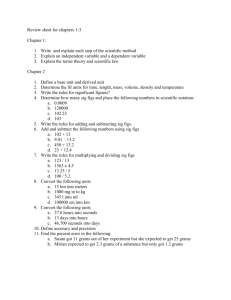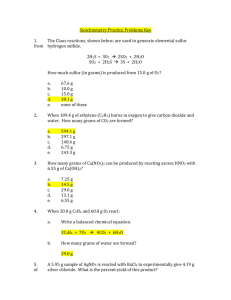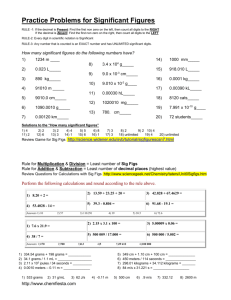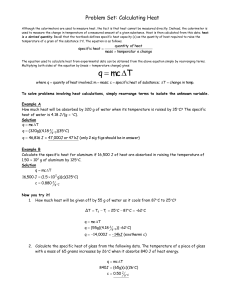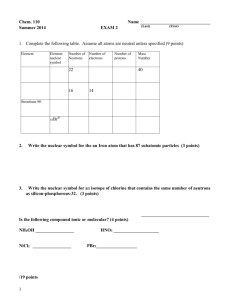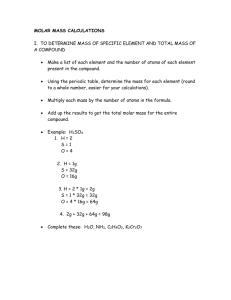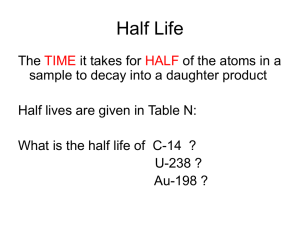Study Guide
advertisement
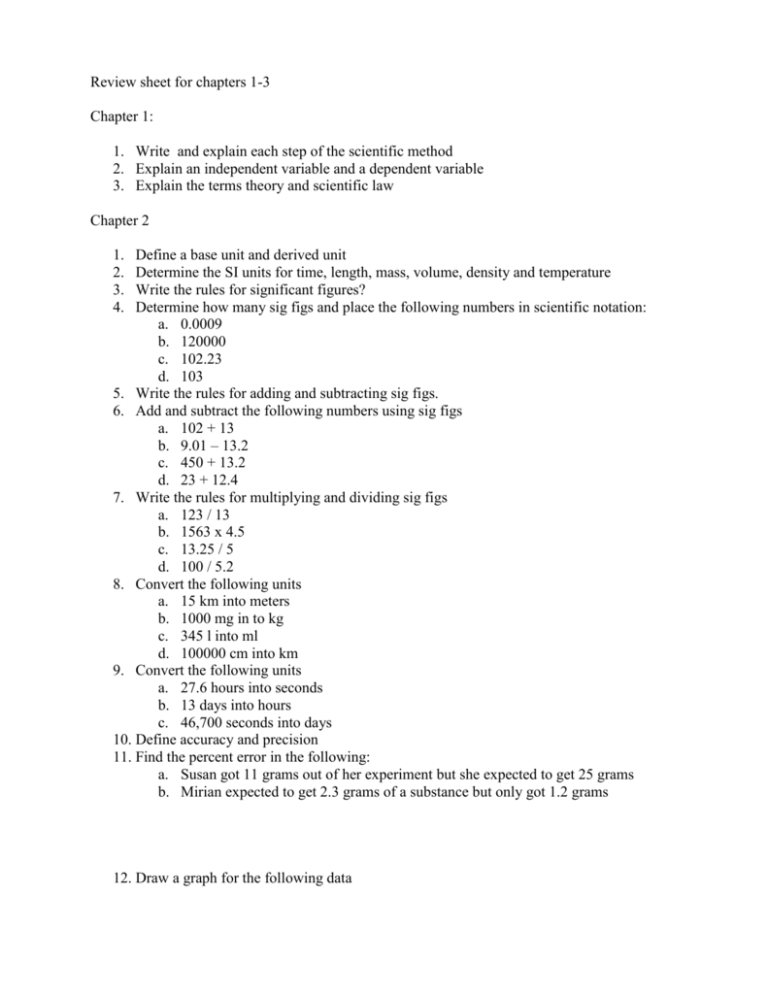
Review sheet for chapters 1-3 Chapter 1: 1. Write and explain each step of the scientific method 2. Explain an independent variable and a dependent variable 3. Explain the terms theory and scientific law Chapter 2 1. 2. 3. 4. Define a base unit and derived unit Determine the SI units for time, length, mass, volume, density and temperature Write the rules for significant figures? Determine how many sig figs and place the following numbers in scientific notation: a. 0.0009 b. 120000 c. 102.23 d. 103 5. Write the rules for adding and subtracting sig figs. 6. Add and subtract the following numbers using sig figs a. 102 + 13 b. 9.01 – 13.2 c. 450 + 13.2 d. 23 + 12.4 7. Write the rules for multiplying and dividing sig figs a. 123 / 13 b. 1563 x 4.5 c. 13.25 / 5 d. 100 / 5.2 8. Convert the following units a. 15 km into meters b. 1000 mg in to kg c. 345 l into ml d. 100000 cm into km 9. Convert the following units a. 27.6 hours into seconds b. 13 days into hours c. 46,700 seconds into days 10. Define accuracy and precision 11. Find the percent error in the following: a. Susan got 11 grams out of her experiment but she expected to get 25 grams b. Mirian expected to get 2.3 grams of a substance but only got 1.2 grams 12. Draw a graph for the following data a. Sarah wants to know in which locations did it rain the most this year Location Number of days it rained Atlanta 20.5 inches Orlando 25.4 inches Chattanooga 15.2 inches Chapter 3 1. Determine and define the three main states of matter 2. Draw a picture of what each state of matter looks like on a molecular level 3. What are the differences between physical and chemical properties? What are the differences between extensive and intensive properties? 4. Determine whether the following are physical or chemical properties. And if they are physical determine if they are extensive or intensive? a. Iron rusting b. Copper having a reddish color c. A sample of water having a mass of 18 grams d. Copper turning green when outside for a long time 5. What is the difference between a chemical and physical change 6. Determine if the following are chemical or physical changes a. Crushing an aluminum can b. Melting ice c. Burning paper d. Burning magnesium to become magnesium oxide 7. State the law of conservation of mass 8. Define what a mixture is 9. Define a heterogeneous mixture and a homogeneous mixture 10. Determine if the following are mixtures or pure substance and if they are mixtures whether they are homogeneous or heterogeneous mixtures a. Water b. A salad c. Carbon dioxide d. Chocolate chip cookies e. Sweet tea f. oxygen 11. describe the different separation techniques: a. filtration b. distillation c. crystallization d. chromatography 12. What are the differences between and element and compound? 13. Determine if the following are elements or compounds a. Hydrogen b. Water c. Carbon monoxide d. oxygen 14. state the law of definite proportions 15. find the percent mass of the following: a. If compound XY has a mass of 55 grams and X makes up 10 grams, what is the mass percent of X b. A compound made up of sulfur and oxygen is made up of 10 grams of oxygen and 32 grams of sulfur. What is the mass percent of sulfur 16. State the law of multiple proportions Chapter 4 1. What were the ideas of atoms of the following philosophers: a. Democritus b. Aristotle c. Dalton 2. What is an atom 3. What are the differences between protons, neutron, and electrons? Where are they located in the atom? 4. Describe the plum pudding model, who came up with it? 5. Explain Rutherford’s gold foil experiment. What did he discover from this? 6. What is an isotope? 7. Fill in the following table: Element name Calcium Element symbol Na Atomic mass Protons Neutrons 12 41 14 7 Bromine 45 8. Describe what radioactivity is and what its purpose is? 9. Describe and draw the symbol for the following radiation: a. Alpha b. Beta c. gamma 10. Write out the following equations: a. The alpha decay of 145-Cerium b. The beta decay of 247-Curium c. The alpha decay of 240-uranium Chapter 5 1. Define the following terms and draw and label a wave with these terms electrons a. Wavelength b. Frequency c. Amplitude d. Crest e. Trough 2. Describe the electromagnetic spectrum 3. Define a quantum and what it means in an atom 4. What is the ground state of an atom 5. What was important about Heisenberg uncertainty principal with the development of the atom 6. What is a principal quantum number? How can you find it on the periodic table? 7. What is a sublevel? What are the four sublevels and where are they located on the periodic table 8. How many orbitals do each sublevel have and what are shapes of the S and P sublevels’ orbitals? 9. Describe aufbau principle, pauli exclusion principle and hund’s rule 10. What are valance electrons and how can you find them on the periodic table? 11. For the following atoms, draw the electron configuration, orbital diagram, noble gas configuration and Lewis dot structure: a. Nitrogen b. Aluminum c. Potassium d. Selenium e. Magnesium Chapter 6 1. Explain what Newlands, Mendeleev, and Mosley did to develop the modern periodic table 2. What are groups and periods on the periodic table? 3. Where can you find the representative and transition elements on the periodic table? 4. What are the properties of Metals, nonmetals, and metalloids 5. Where can alkali metal be found and why are they so reactive 6. Where can the alkaline earth metals be found 7. Where are the transition metals 8. Where are the lanthanide series 9. Where are the actinide series 10. Where are the halogens and why are they so reactive 11. Where are the noble gases and why are the nonreactive 12. State what the trends are on the periodic table: a. Atomic radius b. Electronegativity c. Ionization energy 13. For the following set of atoms state which one has the largest atomic radius a. Carbon or fluorine b. Magnesium or calcium c. Boron or gallium d. Sodium or silicon 14. For the following set of atoms state which one has the largest electronegativity a. Carbon or fluorine b. Magnesium or calcium c. Born or gallium d. Sodium or silicon 15. For the following set of atoms state which one has the largest ionization energy a. Lithium or sodium b. Beryllium or carbon c. Aluminum or sulfur d. Oxygen or selenium 16. State the octet rule Name: ___________________________________ Chemistry B Study Guide Date:__________________ Chapter 7 and Chapter 8: 1. Define a chemical bond 2. State what a cation and anion is, give and example for each, and explain how it became this way? 3. State the octet rule. 4. State two differences between an ionic and covalent compound 5. Explain in steps how to name an ionic compound that contains A). A simple metal and nonmetal, B). A simple metal and polyatomic. C). A transition metal and simple nonmetal 6. Explain in steps how to name a covalent compound. 7. Explain in steps how to identify and how to name an acids 8. Name or write the chemical formula for the following compounds based off of your answers for 5-7 above. Formula Name Formula Name NaCl Iron (II) Oxide NO2 Phosphic acid Al2O3 Disilicon tetrachloride Mn3N Lithium Fluoride H2CO3 Nitrogen trihydride CF4 Copper (II) Chloride CaS Hydrosulfic acid
